Sensor-Based Solid Waste Handling Systems: A Survey
Abstract
:1. Introduction
- A comprehensive analysis of RFID, WSN, and IoT-based approaches towards the automation of solid waste handling systems.
- Each category is analyzed with a typical system architecture. Significance and limitations for the same are discussed.
- Recommends apt communication technology for IoT-based solid waste handling systems.
- The critical open research issues on state-of-the-art solid waste handling systems are concluded from the review and recommendations for future directions are presented.
2. Methodology
- Similar approaches published in different years are excluded from the survey.
- Conference papers with proof of concept are only included for the survey.
3. RFID Based Solid Waste Management Systems
- To obtain information on the waste collection area and the respective collecting time;
- To develop a system for monitoring and tracking of waste collection trucks and waste bins;
- To obtain information on the quantity of solid waste inside the bin and the surroundings.
3.1. System Architecture
RFID-Enabled Trash Bin Level Monitoring Systems
- RFID-based systems are unable to provide continuous real-time monitoring of the bin’s filled level;
- Trash bins are monitored only when the truck is within the range of RFID tags;
- RFID tags are using to identify the bins uniquely and they do not provide any data on the filled levels of the bins;
- Additional infrastructure is required to obtain the filled levels of the trash bins.
4. Wireless Sensor Networks Based Solid Waste Management Systems
- Capacity for dealing with node failures;
- Optimal for nodes equipped with batteries;
- Nodes mobility and heterogeneity;
- Scalability to a vast distribution scale.
4.1. Network Architecture
WSN-Based Trash Bin Level Monitoring Systems
5. IoT-Enabled Solid Waste Management Systems
- No missed pickups: The data recorded from the smart bins assist in reducing missed pickups. The authorities will be automatically notified if the sensors detect that the garbage container is full. Then, the IoT waste management system enables the scheduling of next pickup for this location. This simplifies the process of waste management and reduces overflowing garbage cans.
- Waste production analysis: Throughout the day, the connected devices keep track of how quickly the bins fill up and how often they empty in different locations. The analysis of these data opens the possibilities of better trash bin distribution, elimination of improper disposal techniques, and even waste reduction at the landfill.
- Route Optimization: The real-time data provided by the smart trash bins can be used to determine the best paths for garbage collection by prioritizing the most required regions.
5.1. Network Architecture
- IoT end device: It consists of sensors to measure the unfilled level or weight of the trash bins, a microcontroller to perform local processing, and a radio device to establish wireless connectivity with gateways or base stations.
- Gateway or Base stations: Several communication technologies are available to establish connectivity between the end devices and the cloud server. According to the adopted wireless technology, the gateway or base station will act as a bridge between the end devices and the cloud server. For instance, a gateway for LoRaWAN devices, a base station for Sigfox and NB IoT devices, and a wireless router for Wi-Fi devices.
- Cloud Server: For IoT applications, cloud servers are preferred due to their flexibility, scalability, and secure authentication process.
- End-user: Remotely monitoring a system can be performed by the end-user. The end-user may be an employee of the solid waste management company or a person in charge of the solid waste collection department in a municipality or corporation. A hierarchical view of trash bins’ filled level can be obtained through a web page or application software.
IoT Embedded Trash Bin Level Monitoring Systems
- LoRaWAN is an open specification, whereas NB-IoT and Sigfox are proprietary network protocols.
- LoRaWAN allows the establishment of private networks in which sensor nodes, gateways, and backhaul can be deployed by the user for a specific application. This is in contrast to NB-IoT and Sigfox, where a user needs to pay for connecting their sensor to the networks.
- LoRaWAN supports firmware upgrade over the air (FUOTA) that enables the remote firmware update of the multiple devices deployed over the network.
- LoRaWAN supports the Adaptive Data Rate mechanism for the optimization of power consumption, airtime, and data rates, whereas NB-IoT and Sigfox do not support this feature.
6. Comparison and Discussion
7. Research Gaps and Future Direction
- Self-powered end nodes: IoT systems comprise a large number of end nodes and gateways or base stations; while the end nodes are deployed at various locations, the gateways or base stations gather the data from the end nodes and send it to the internet for further analysis. The end nodes are preferably powered with batteries, and the frequent replacement of batteries is impractical when considering the wide range deployment of nodes. Some works in the literature proposed energy harvesting by using solar panels to address this issue. Still, there is a large scope of systems that need to adopt advanced methodologies to enhance the design of IoT-enabled solid waste handling systems with self-powered end nodes:
- Edge computing enabled waste segregation: Currently, waste segregation is implemented by placing multi-colored or labeled bins for the easy classification of the waste material. Even if it is an easy method of collecting a particular kind of waste, this approach cannot always be successful because, by mistake, people may place waste in the wrong bins and it will disturb proper segregation. Nevertheless, waste segregation by the bin itself would be a solution. There is a solid research scope in the aforementioned scenario to design edge computing-enabled smart nodes incorporated with image processing techniques to implement waste segregation.
- Hybrid network architecture: Waste generation is dynamic and varies concerning the environment. For instance, the frequency of filling of a trash bin installed at public places will be dynamic and the filling of trash bins installed at houses or residential areas will be probably in a uniform manner. From the survey performed on existing approaches, it is evident that LPWAN communication technologies are best suited for monitoring bins at public places since bins are deployed at distant locations. Similarly, short-range communication technologies such as Wi-Fi are best suited for monitoring trash bins located at houses since most houses will be equipped with a Wi-Fi router for internet connectivity. Nevertheless, none of the existing systems describe solid waste management models or network architectures for waste management in flats or apartments. Moreover, waste management in urban areas is incomplete without addressing the aforementioned scenario. As a result, a lot of research attention is required in developing hybrid network architectures that are capable to address the solid waste management requirements in public areas and residential areas differently.
- Smart Transportation: Transportation plays a crucial role in an efficient waste management system. Most of the existing approaches send the trash bin status to the central monitoring station or cloud servers for performing data analysis. On the basis of this analysis, waste collection routes will be scheduled and a truck or waste collection vehicle shall follow this scheduled path for optimized waste collection. Meanwhile, an unscheduled trash bin may become completely filled and miss the pick up. Thus, there is a need for dynamic path optimization centered on the waste collection vehicles’ live location and the real-time status of the trash bins.
- Customized node design: Based on the study performed on the various solid waste management systems, it is inferred that most of the end nodes are employed with development or evaluation boards. Consequently, the performance metrics obtained for those nodes will have some tolerance levels when compared with dedicated nodes designed for trash bin monitoring. Even though some works in the literature have designed customized nodes for compactness and power efficiency, there is still a scope for further enhancement. For instance, the majority of works considered in this study follow some hypothetical conditions, such as the waste-filled level being uniform and a single ultrasonic sensor can detect the unfilled level of the trash bins. However, in real scenarios, an end node with a single sensor will not be sufficient for detecting the unfilled level of larger trash bins. Therefore, there is a need for customized end nodes with multiple sensors for detecting the unfilled levels of larger trash bins efficiently.
8. Conclusions
Author Contributions
Funding
Institutional Review Board Statement
Informed Consent Statement
Data Availability Statement
Conflicts of Interest
References
- Magazzino, C.; Mele, M.; Schneider, N.; Sarkodie, S. A Waste generation, wealth and GHG emissions from the waste sector: Is Denmark on the path towards circular economy? Sci. Total Environ. 2021, 755, 142510. [Google Scholar] [CrossRef] [PubMed]
- Siritorn, K.; Permpoonwiwat, C.K. Effects of area characteristics and municipal waste collection fees on household waste generation. J. Mater. Cycles Waste Manag. 2020, 22, 89–96. [Google Scholar] [CrossRef]
- Rajendiran, B.; Arumugam, A.; Subramaniam, S. Challenges in municipal solid waste management: A key. Int. J. Ambient. Energy 2020, 1–11. [Google Scholar] [CrossRef]
- Arain, A.L.; Pummill, R.; Adu-Brimpong, J.; Becker, S.; Green, M.; Ilardi, M.; Van Dam, E.; Neitzel, R.L. Analysis of e-waste recycling behavior based on survey at a Midwestern US University. Waste Manag. 2020, 105, 119–127. [Google Scholar] [CrossRef] [PubMed]
- Ahmad, R.W.; Salah, K.; Jayaraman, R.; Yaqoob, I.; Omar, M. Blockchain for Waste Management in Smart Cities: A Survey. IEEE Access 2021, 9, 131520–131541. [Google Scholar] [CrossRef]
- Mirzaii, H.; Shaarbafchi Zadeh, N.; Hamidi, F.; Rahmani, K.; Darabi, M.; Marjan, A. A survey of waste management status in selected hospitals in Isfahan. J. Health-Based Res. 2020, 5, 343–353. [Google Scholar]
- Awuchi, C.G.; Twinomuhwezi, H.; Awuchi, C.G.; Victory, I.S. Industrial Waste Management, Treatment, and Health Issues: Wastewater, Solid, and Electronic Wastes. Eur. Acad. Res. 2020, 8, 1081–1119. [Google Scholar]
- Kaza, S.; Yao, L.; Bhada-Tata, P.; Van Woerden, F. What a Waste 2.0: A Global Snapshot of Solid Waste Management to 2050; World Bank Publications: Washington, DC, USA, 2018. [Google Scholar]
- Shittu, O.S.; Williams, I.D.; Shaw, P.J. Global E-waste management: Can WEEE make a difference? A review of e-waste trends, legislation, contemporary issues and future challenges. Waste Manag. 2020, 120, 549–563. [Google Scholar] [CrossRef]
- Di Foggia, G.; Beccarello, M. Drivers of municipal solid waste management cost based on cost models inherent to sorted and unsorted waste. Waste Manag. 2020, 114, 202–214. [Google Scholar] [CrossRef]
- Wong, S.; Mah, A.X.Y.; Nordin, A.H.; Nyakuma, B.B.; Ngadi, N.; Mat, R.; Amin, N.A.S.; Ho, W.S.; Lee, T.H. Emerging trends in municipal solid waste incineration ashes research: A bibliometric analysis from 1994 to 2018. Environ. Sci. Pollut. Res. 2020, 27, 7757–7784. [Google Scholar] [CrossRef]
- Lu, J.-W.; Chang, N.-B.; Liao, L. Environmental informatics for solid and hazardous waste management: Advances, challenges, and perspectives. Crit. Rev. Environ. Sci. Technol. 2013, 43, 1557–1656. [Google Scholar] [CrossRef]
- Hannan, M.A.; Al Mamun, M.A.; Hussain, A.; Basri, H.; Begum, R.A. A review on technologies and their usage in solid waste monitoring and management systems: Issues and challenges. Waste Manag. 2015, 43, 509–523. [Google Scholar] [CrossRef] [PubMed]
- de Souza Melaré, A.V.; González, S.M.; Faceli, K.; Casadei, V. Technologies and decision support systems to aid solid-waste management: A systematic review. Waste Manag. 2017, 59, 567–584. [Google Scholar] [CrossRef] [PubMed]
- Pardini, K.; Rodrigues, J.J.; Kozlov, S.A.; Kumar, N.; Furtado, V. IoT-based solid waste management solutions: A survey. J. Sens. Actuator Netw. 2019, 8, 5. [Google Scholar] [CrossRef] [Green Version]
- Akram, S.V.; Singh, R.; Gehlot, A.; Rashid, M.; AlGhamdi, A.S.; Alshamrani, S.S.; Prashar, D. Role of Wireless Aided Technologies in the Solid Waste Management: A Comprehensive Review. Sustainability 2021, 13, 13104. [Google Scholar] [CrossRef]
- Ramson, S.J.; Bhavanam, D.; Draksharam, S.; Kumar, R.; Moni, D.J.; Kirubaraj, A.A. Radio Frequency Identification and Sensor Networks based Bin Level Monitoring Systems—A Review. In Proceedings of the 2018 4th International Conference on Devices, Circuits and Systems (ICDCS), Coimbatore, India, 16–17 March 2018. [Google Scholar]
- Motroni, A.; Buffi, A.; Nepa, P. A survey on indoor vehicle localization through RFID technology. IEEE Access 2021, 9, 17921–17942. [Google Scholar] [CrossRef]
- Noer, A.; Hasanuddin, Z.B.; Djamaluddin, D. Implementation of RFID based raspberry Pi for user authentication and offline intelligent payment system. In Proceedings of the 2017 15th International Conference on Quality in Research (QiR): International Symposium on Electrical and Computer Engineering, Nusa Dua, Bali, Indonesia, 24–27 July 2017. [Google Scholar]
- Al-Shabibi, L.; Jayaraman, N.; Vrindavanam, J. Automobile speed violation detection system using RFID and GSM technologies. Int. J. Appl. Inf. Syst. 2014, 7, 24–29. [Google Scholar] [CrossRef]
- Bayani, M.; Segura, A.; Alvarado, M.; Loaiza, M. IoT-based library automation and monitoring system: Developing an implementation framework of implementation. E-Cienc. Inf. 2018, 8, 83–100. [Google Scholar] [CrossRef] [Green Version]
- Angeles, R. RFID technologies: Supply-chain applications and implementation issues. Inf. Syst. Manag. 2005, 22, 51–65. [Google Scholar] [CrossRef]
- Chamekh, M.; El Asmi, S.; Hamdi, M.; Kim, T.H. Context aware middleware for rfid based pharmaceutical supply chain. In Proceedings of the 2017 13th International Wireless Communications and Mobile Computing Conference (IWCMC), Valencia, Spain, 26–30 June 2017. [Google Scholar]
- Elbasani, E.; Siriporn, P.; Choi, J.S. A Survey on RFID in Industry 4.0. Internet of Things for Industry 4.0; Springer: Cham, Switzerland, 2020; pp. 1–16. [Google Scholar]
- Akter, R.; Khandaker, M.J.H.; Ahmed, S.; Mugdho, M.M.; Haque, A.B. RFID based smart transportation system with android application. In Proceedings of the 2020 2nd International Conference on Innovative Mechanisms for Industry Applications (ICIMIA), Bangalore, India, 5–7 March 2020. [Google Scholar]
- Ali, M.L.; Alam, M.; Rahaman, M.A.N.R. RFID based e-monitoring system for municipal solid waste management. In Proceedings of the 2012 7th International Conference on Electrical and Computer Engineering, Dhaka, Bangladesh, 20–22 December 2012. [Google Scholar]
- Hannan, M.A.; Arebey, M.; Begum, R.A.; Basri, H. Radio Frequency Identification (RFID) and communication technologies for solid waste bin and truck monitoring system. Waste Manag. 2011, 31, 2406–2413. [Google Scholar] [CrossRef]
- Arebey, M.; Hannan, M.A.; Basri, H.; Begum, R.A.; Abdullah, H. Integrated technologies for solid waste bin monitoring system. Environ. Monit. Assess. 2011, 177, 399–408. [Google Scholar] [CrossRef] [PubMed]
- Tao, C.; Xiang, L. Municipal solid waste recycle management information platform based on internet of things technology. In Proceedings of the 2010 International Conference on Multimedia Information Networking and Security, Nanjing, China, 4–6 November 2010. [Google Scholar]
- Vicentini, F.; Giusti, A.; Rovetta, A.; Fan, X.; He, Q.; Zhu, M.; Liu, B. Sensorized waste collection container for content estimation and collection optimization. Waste Manag. 2009, 29, 1467–1472. [Google Scholar] [CrossRef] [PubMed]
- Chowdhury, B.; Chowdhury, M.U. RFID-based real-time smart waste management system. In Proceedings of the 2007 Australasian Telecommunication Networks and Applications Conference, Christchurch, New Zealand, 2–5 December 2007. [Google Scholar]
- Lu, J.-W.; Chang, N.-B.; Liao, L.; Liao, M.-Y. Smart and green urban solid waste collection systems: Advances, challenges, and perspectives. IEEE Syst. J. 2015, 11, 2804–2817. [Google Scholar] [CrossRef]
- Abd Wahab, M.H.; Kadir, A.A.; Tomari, M.R.; Jabbar, M.H. Smart recycle bin: A conceptual approach of smart waste management with integrated web based system. In Proceedings of the 2014 International Conference on IT Convergence and Security (ICITCS), Beijing, China, 28–30 October 2014. [Google Scholar]
- Karthikeyan, S.; Rani, G.S.; Sridevi, M.; Bhuvaneswari, P.T.V. IoT enabled waste management system using ZigBee network. In Proceedings of the 2017 2nd IEEE International Conference on Recent Trends in Electronics, Information and Communication Technology (RTEICT), Bangalore, India, 19–20 May 2017. [Google Scholar]
- Raaju, V.A.; Meeran, J.M.; Sasidharan, M.; Premkumar, K. IOT based smart garbage monitoring system using ZigBee. In Proceedings of the 2019 IEEE International Conference on System, Computation, Automation and Networking (ICSCAN), Pondicherry, India, 29–30 March 2019. [Google Scholar]
- Longhi, S.; Marzioni, D.; Alidori, E.; Di Buo, G.; Prist, M.; Grisostomi, M.; Pirro, M. Solid waste management architecture using wireless sensor network technology. In Proceedings of the 2012 5th International Conference on New Technologies, Mobility and Security (NTMS), Istanbul, Turkey, 7–10 May 2012. [Google Scholar]
- Ramson, S.J.; Moni, D.J. Wireless sensor networks based smart bin. Comput. Electr. Eng. 2017, 64, 337–353. [Google Scholar] [CrossRef]
- Ramson, S.R.J.; Moni, D.J.; Kirubaraj, A.A.; Senith, S. Self-powered wireless sensor network framework to monitor bin level. J. Solid Waste Technol. Manag. 2017, 43, 295–304. [Google Scholar] [CrossRef]
- Ramson, S.R.; Moni, D.J.; Vishnu, S.; Anagnostopoulos, T.; Kirubaraj, A.A.; Fan, X. An IoT-based bin level monitoring system for solid waste management. J. Mater. Cycles Waste Manag. 2021, 23, 516–525. [Google Scholar] [CrossRef]
- Kashani, M.H.; Madanipour, M.; Nikravan, M.; Asghari, P.; Mahdipour, E. A systematic review of IoT in healthcare: Applications, techniques, and trends. J. Netw. Comput. Appl. 2021, 192, 103164. [Google Scholar] [CrossRef]
- Catania, V.; Ventura, D. An approch for monitoring and smart planning of urban solid waste management using smart-M3 platform. In Proceedings of the 15th Conference of Open Innovations Association FRUCT, St. Petersburg, Russia, 21–25 April 2014. [Google Scholar]
- Aazam, M.; St-Hilaire, M.; Lung, C.H.; Lambadaris, I. Cloud-based smart waste management for smart cities. In Proceedings of the 2016 IEEE 21st International Workshop on Computer Aided Modelling and Design of Communication Links and Networks (CAMAD), Toronto, ON, Canada, 23–25 October 2016. [Google Scholar]
- Saha, H.N.; Auddy, S.; Pal, S.; Kumar, S.; Pandey, S.; Singh, R.; Singh, A.K.; Banerjee, S.; Ghosh, D.; Saha, S. Waste management using internet of things (IoT). In Proceedings of the 2017 8th Annual Industrial Automation and Electromechanical Engineering Conference (IEMECON), Bangkok, Thailand, 16–18 August 2017. [Google Scholar]
- Thakker, S.; Narayanamoorthi, R. Smart and wireless waste management. In Proceedings of the 2015 International Conference on Innovations in Information, Embedded and Communication Systems (ICIIECS), Coimbatore, India, 19–20 March 2015. [Google Scholar]
- Folianto, F.; Low, Y.S.; Yeow, W.L. Smartbin: Smart waste management system. In Proceedings of the 2015 IEEE Tenth International Conference on Intelligent Sensors, Sensor Networks and Information Processing (ISSNIP), Singapore, 7–9 April 2015. [Google Scholar]
- Ramya, E.; Sasikumar, R. A survey of smart environment conservation and protection for waste management. In Proceedings of the 2017 Third International Conference on Advances in Electrical, Electronics, Information, Communication and Bio-Informatics (AEEICB), Chennai, India, 27–28 February 2017. [Google Scholar]
- Tambare, P.; Venkatachalam, P. IoT based waste management for smart city. Int. J. Innov. Res. Comput. Commun. Eng. 2016, 4, 1267–1274. [Google Scholar]
- Bor, M.; Vidler, J.E.; Roedig, U. LoRa for the Internet of Things. In Proceedings of the 2016 International Conference on Embedded Wireless Systems and Networks, Graz, Austria, 15–17 February 2016; pp. 361–366. [Google Scholar]
- Vejlgaard, B.; Lauridsen, M.; Nguyen, H.; Kovács, I.Z.; Mogensen, P.; Sorensen, M. Coverage and capacity analysis of sigfox, lora, gprs, and nb-iot. In Proceedings of the 2017 IEEE 85th Vehicular Technology Conference (VTC Spring), Sydney, NSW, Australia, 4–7 June 2017; pp. 1–5. [Google Scholar]
- Gomez, C.; Veras, J.C.; Vidal, R.; Casals, L.; Paradells, J. A sigfox energy consumption model. Sensors 2019, 19, 681. [Google Scholar] [CrossRef] [Green Version]
- Sheng, T.J.; Islam, M.S.; Misran, N.; Baharuddin, M.H.; Arshad, H.; Islam, M.R.; Chowdhury, M.E.H.; Rmili, H.; Islam, M.T. An internet of things based smart waste management system using LoRa and tensorflow deep learning model. IEEE Access 2020, 8, 148793–148811. [Google Scholar] [CrossRef]
- Addabbo, T.; Fort, A.; Mecocci, A.; Mugnaini, M.; Parrino, S.; Pozzebon, A.; Vignoli, V. A lora-based iot sensor node for waste management based on a customized ultrasonic transceiver. In Proceedings of the 2019 IEEE Sensors Applications Symposium (SAS), Sophia Antipolis, France, 11–13 March 2019. [Google Scholar]
- Cerchecci, M.; Luti, F.; Mecocci, A.; Parrino, S.; Peruzzi, G.; Pozzebon, A. A low power IoT sensor node architecture for waste management within smart cities context. Sensors 2018, 18, 1282. [Google Scholar] [CrossRef] [PubMed] [Green Version]
- Lozano, Á; Caridad, J.; De Paz, J.F.; Villarrubia Gonzalez, G.; Bajo, J. Smart waste collection system with low consumption LoRaWAN nodes and route optimization. Sensors 2018, 18, 1465. [Google Scholar] [CrossRef] [PubMed] [Green Version]
- Beliatis, M.J.; Mansour, H.; Nagy, S.; Aagaard, A.; Presser, M. Digital waste management using LoRa network a business case from lab to fab. In Proceedings of the 2018 Global Internet of Things Summit (GIoTS), Bilbao, Spain, 4–7 June 2018; pp. 1–6. [Google Scholar]
- Ramson, S.J.; Vishnu, S.; Kirubaraj, A.A.; Anagnostopoulos, T.; Abu-Mahfouz, A.M. A LoRaWAN IoT enabled Trash Bin Level Monitoring System. IEEE Trans. Ind. Inform. 2021, 18, 786–795. [Google Scholar] [CrossRef]
- Akram, S.V.; Singh, R.; AlZain, M.A.; Gehlot, A.; Rashid, M.; Faragallah, O.S.; El-Shafai, W.; Prashar, D. Performance Analysis of IoT and Long-Range Radio-Based Sensor Node and Gateway Architecture for Solid Waste Management. Sensors 2021, 21, 2774. [Google Scholar] [CrossRef] [PubMed]
- Vishnu, S.; Ramson, S.R.J.; Senith, S.; Anagnostopoulos, T.; Abu-Mahfouz, A.M.; Fan, X.; Srinivasan, S.; Kirubaraj, A.A. IoT-Enabled Solid Waste Management in Smart Cities. Smart Cities 2021, 4, 1004–1017. [Google Scholar] [CrossRef]
- Available online: https://bigbelly.com (accessed on 17 January 2022).
- Available online: https://https://bine.world (accessed on 17 January 2022).
- Available online: https://http://ecobins.pl/en/homepage (accessed on 17 January 2022).
- Available online: https://nordsense.com (accessed on 17 January 2022).

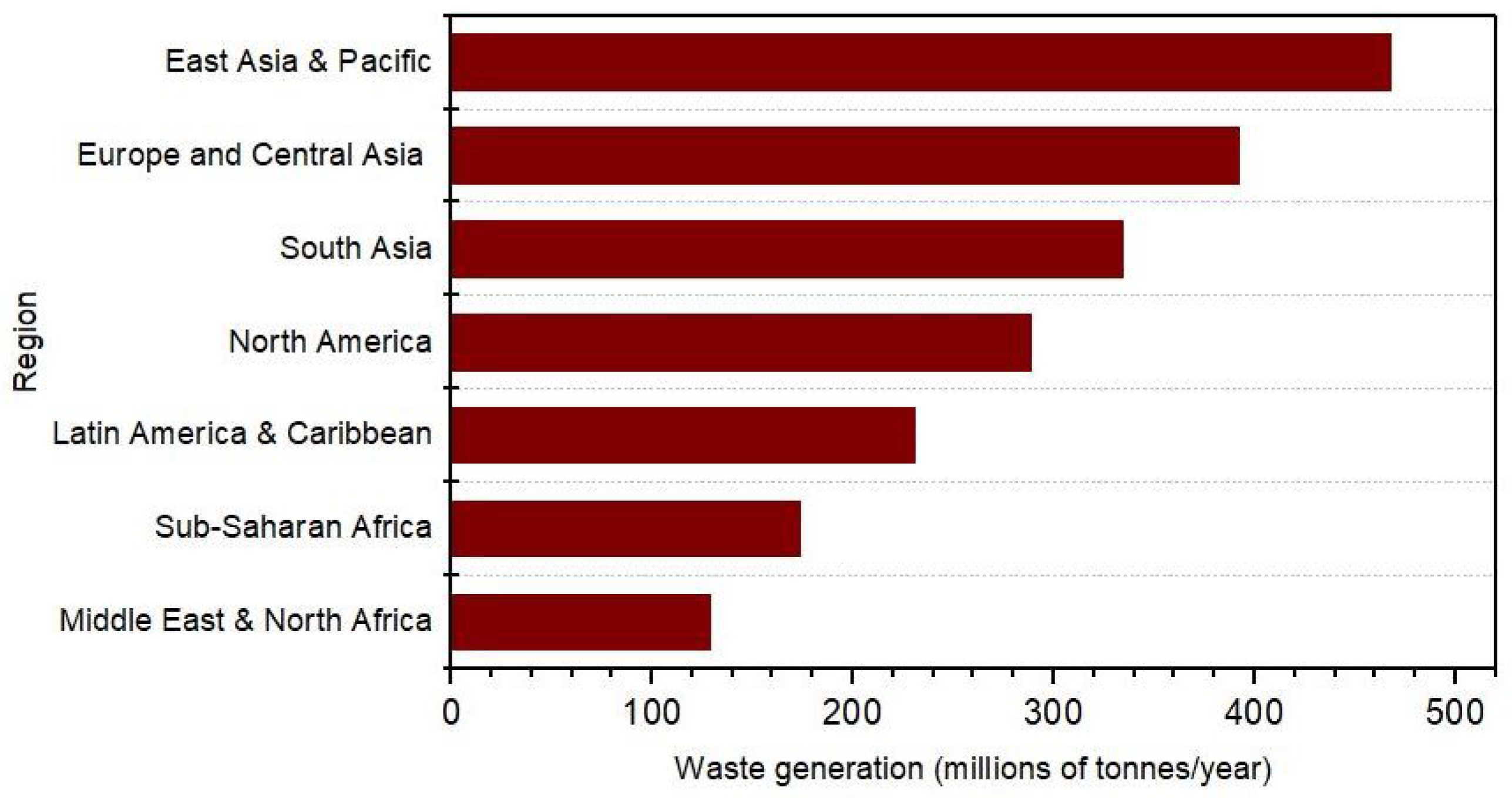
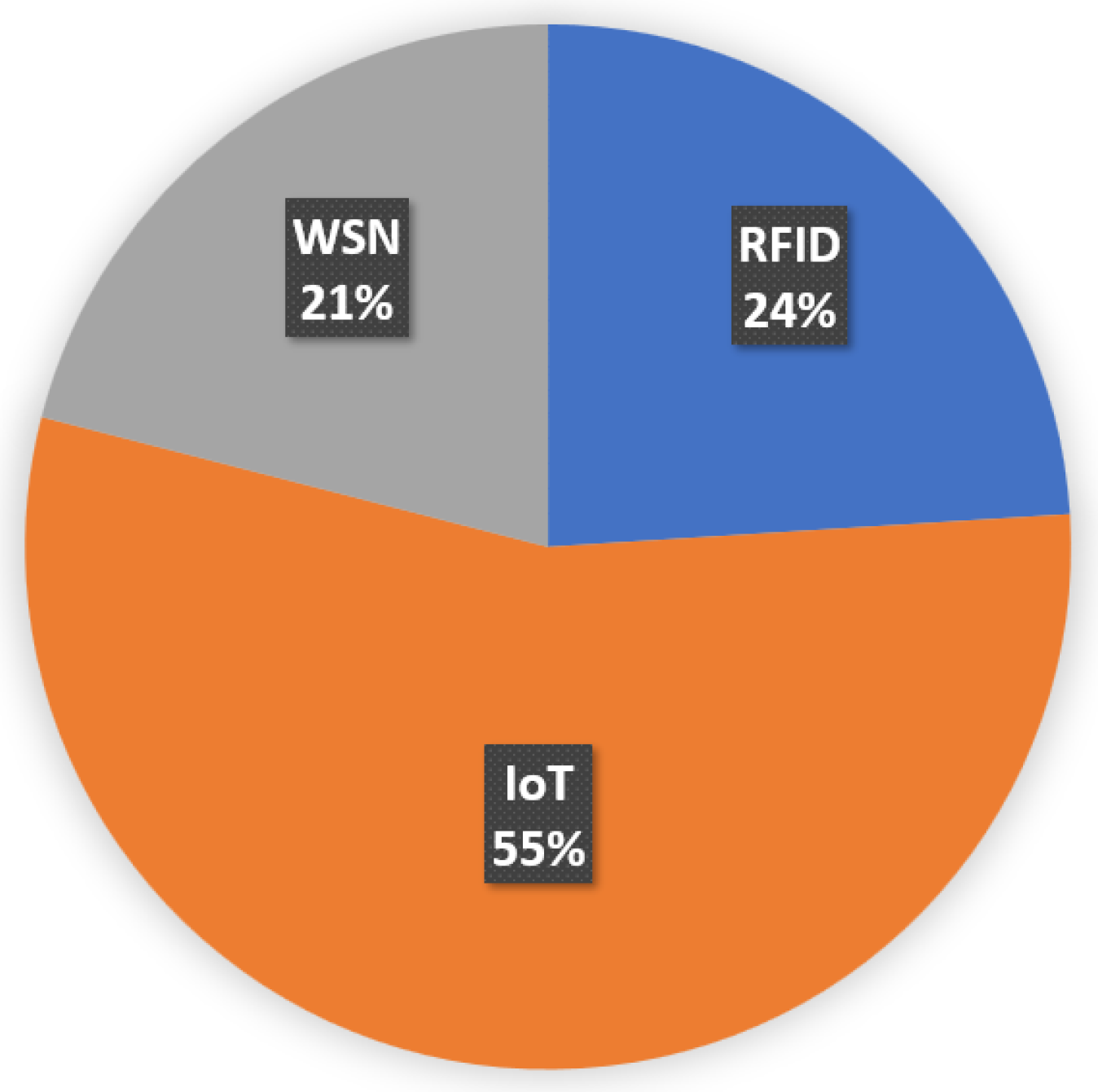
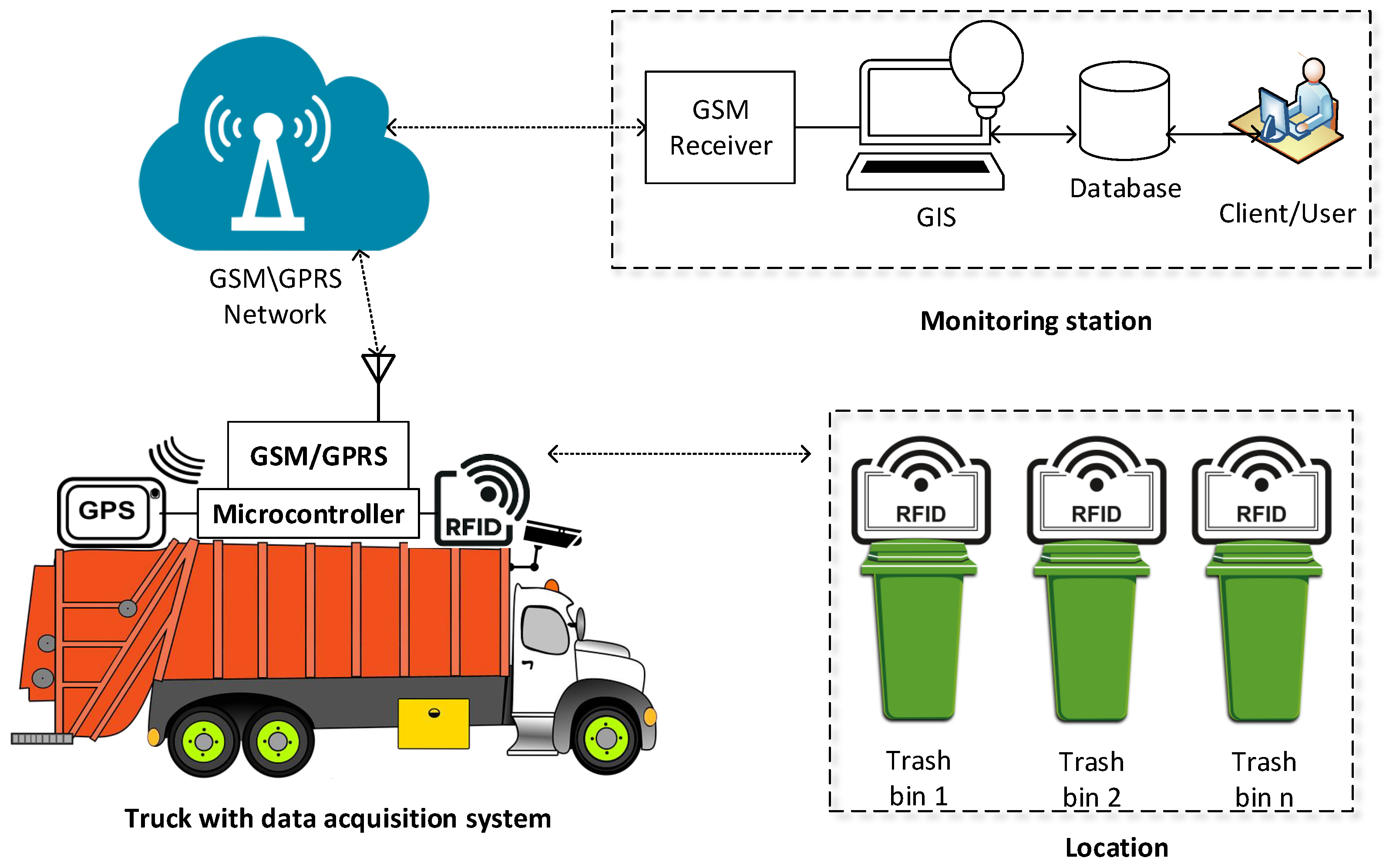
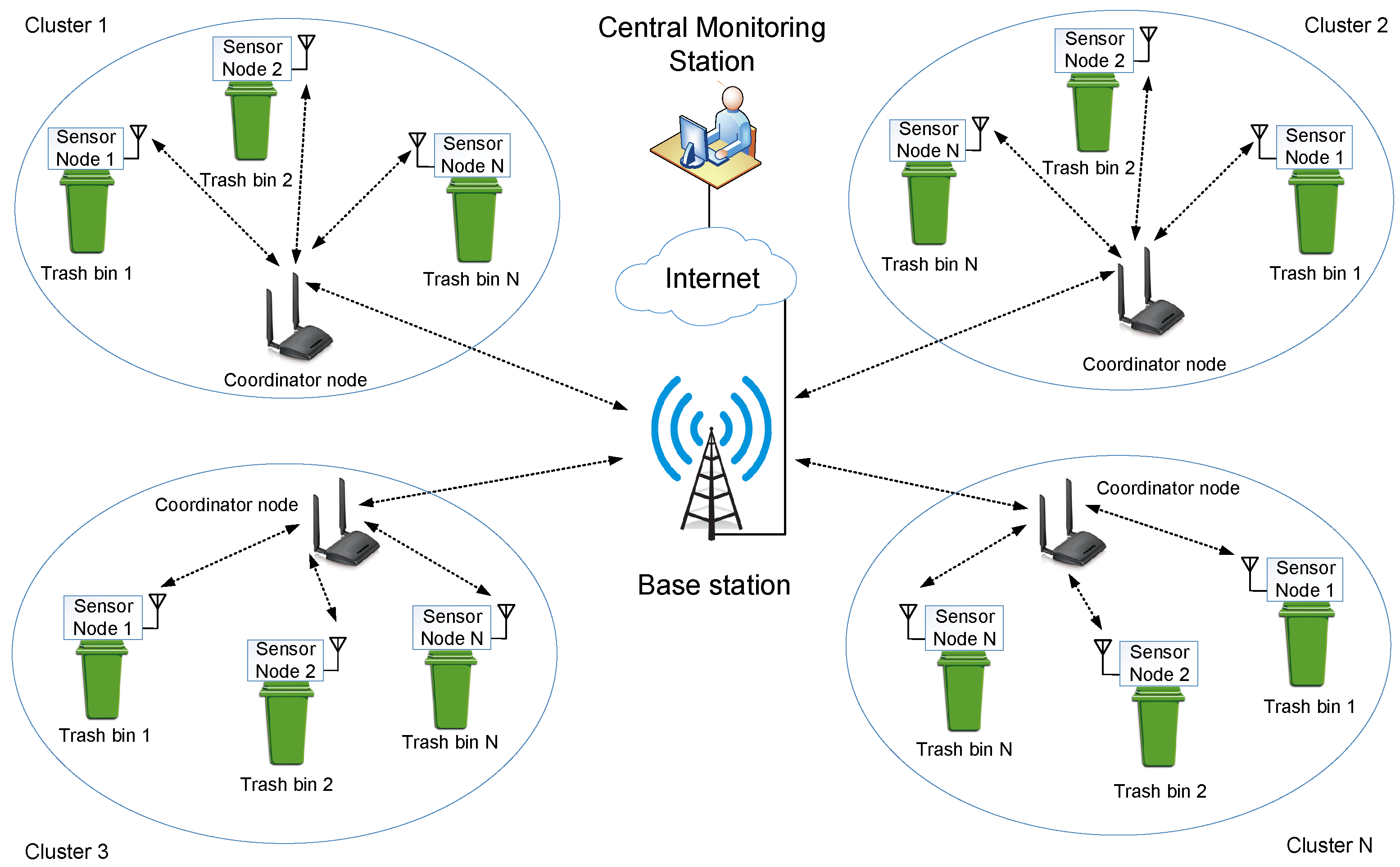
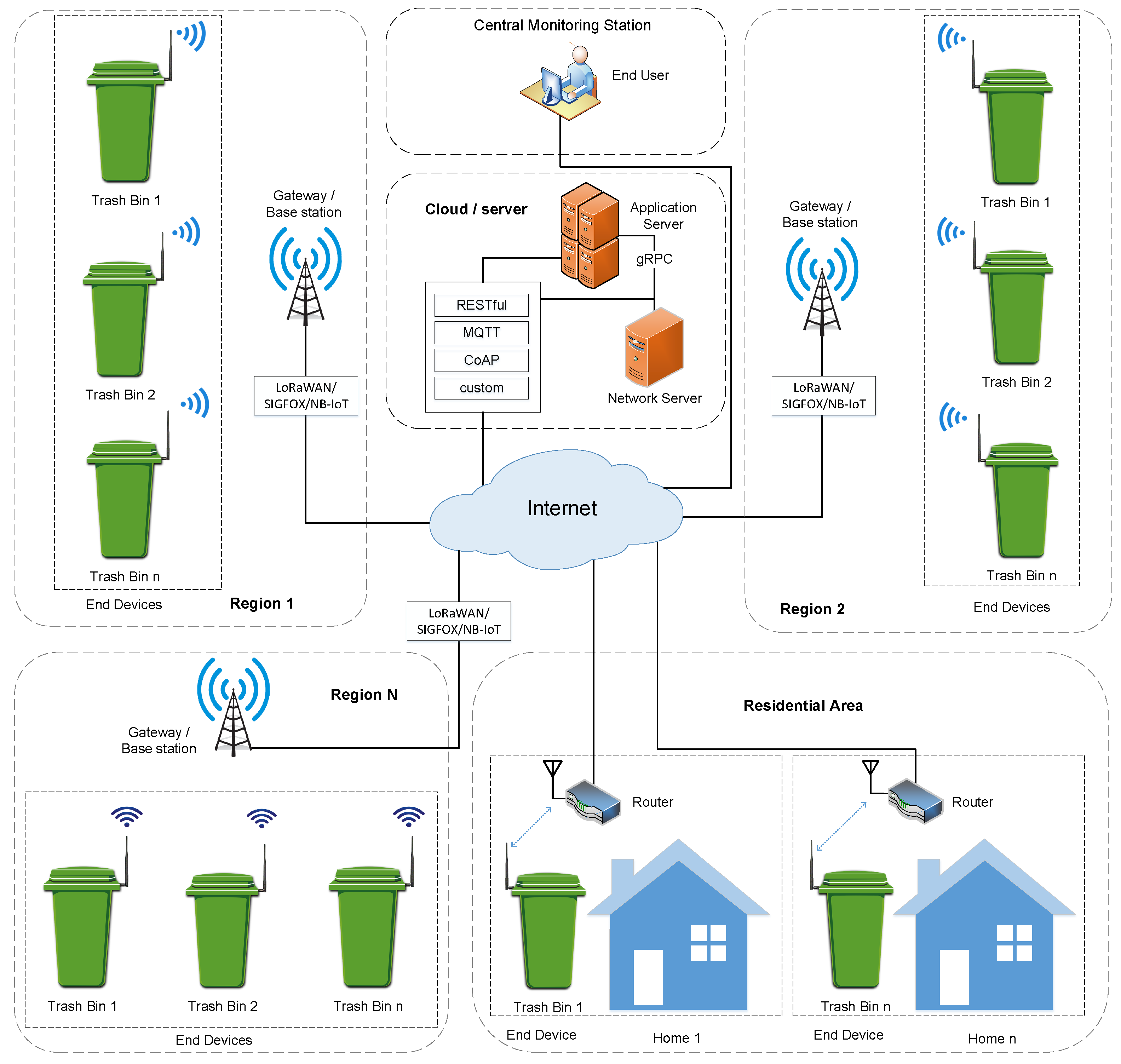
| Ref. | Bin Deployment | Sensors | Camera | GPS | GIS | Routing |
|---|---|---|---|---|---|---|
| [27] | exterior | none | Yes | Yes | Yes | undefined |
| [28] | exterior | none | Yes | Yes | Yes | undefined |
| [29] | not specified | infrared sensor | No | Yes | No | undefined |
| [30] | exterior | ultrasonic sensor, pressure sensor, | Yes | Yes | Yes | undefined |
| [31] | exterior | load cell sensor | No | No | No | undefined |
| [32] | interior/exterior | photoelectric, image sensor | No | Yes | No | defined |
| [33] | exterior | digital weight scale | No | No | No | undefined |
| Wireless Technology | Wireless Range | Power Consumption | Operating Frequency | Data Rate |
|---|---|---|---|---|
| Zigbee | 10–100 m | Low | 2.4 GHz | 20–250 kbps |
| Wi-Fi | 100 m | Medium | 2.4 GHz, 5 GHz | 10–100 Mbps |
| Bluetooth LE | >100 m | Low | 2.4 GHz | 125 kbps–2 Mbps |
| Z-Wave | 15–150 m | Low | sub-GHz | 9.6–40 kbps |
| IEEE 802.15.4 | 10–20 m | Low | 2.4 GHz | 250 kbps |
| SimpliciTi | 50 m | Low | 2.4 GHz | 250 kbps |
| Ref. | Sensor | Microcontroller | Wireless Technology | Communication Network | GPS | Visualization | Energy Harvesting |
|---|---|---|---|---|---|---|---|
| [34] | Ultrasonic sensor | Arduino Uno | Zigbee | Mesh | Yes | No | No |
| [35] | Ultrasonic sensor | Arduino Pro Mini | Zigbee | Star | Yes | No | Yes |
| [36] | ArgosD sensor | MSP430F1611 | IEEE 802.15.4 | LoWPAN | No | Yes | No |
| [37] | Ultrasonic sensor | MSP430F2274 | SimpliciTi | WLAN | No | Yes | No |
| [38] | Ultrasonic sensor | MSP430F2274 | SimpliciTi | WLAN | No | Yes | Yes |
| [39] | Ultrasonic sensor | ATSAMW25H18 | Wi-Fi | WLAN | No | Yes | Yes |
| Ref. | Sensors | Radio Technology | Wireless Range | GPS | Energy Harvesting |
|---|---|---|---|---|---|
| [41] | weight sensor, proximity sensor | Zigbee | Short | No | No |
| [42] | level sensor | Not Specified | Not Specified | No | No |
| [43] | Not Specified | Wi-Fi | Short | No | Yes |
| [44] | Ultrasonic sensor, load cell | GSM | long | Yes | No |
| [45] | Ultrasonic sensor | Wi-Fi | short | Yes | No |
| [46] | Ultrasonic sensor | GSM | long | No | No |
| [47] | IR sensor | RF | Short | No | No |
| Communication Technology | Wireless Range | Power Consumption | Operating Frequency | Data Rate | Modulation Technique |
|---|---|---|---|---|---|
| LoRaWAN | <15 km | Low | Sub-GHz | 0.3–50 kbps | SS Chirp |
| SigFox | 50 km | Low | Sub-GHz | 100 bps | DBPSK |
| NB-IoT | <35 km | Low | Cellular Bands | 200 kbps | QPSK |
| Ref. | Sensor | Microcontroller | Radio Device (LoRa) | Custom Node Design | GPS | Energy Harvesting | Real Time Deployment |
|---|---|---|---|---|---|---|---|
| [51] | Camera, Ultrasonic Sensor | Arduino Uno | SX 1272 | Yes | Yes | Yes | Yes |
| [52] | Ultrasonic Sensor | Atmega328P | SX 1272 | Yes | No | No | Yes |
| [53] | Ultrasonic Sensor | Atmega328P | SX 1278 | Yes | No | No | Yes |
| [54] | Ultrasonic Sensor, Load cell, Temperature sensor | ATSAML21 | SX 1276 | Yes | No | No | Not Specified |
| [55] | Ultrasonic Sensor | Raspberry Pi3 | IP67 LoRa gateway | Yes | No | No | Not Specified |
| [56] | Ultrasonic Sensor | ATmega 2560 | RN2903 | Yes | Yes | Yes | Yes |
| [57] | Ultrasonic Sensor | Atmega328P | SX 1278 | Yes | No | No | Yes |
| [58] | Ultrasonic Sensor | ATmega 2560 | RN2903 | Yes | Yes | Yes | Yes |
| Ref. | Title of the Project | Estimated Prototype Cost in USD |
|---|---|---|
| [39] | An IoT-based bin level monitoring system for solid waste management | 107 |
| [51] | An internet of things based smart waste management system using LoRa and tensorflow deep learning model | 180 |
| [53] | A low power IoT sensor node architecture for waste management within smart cities context | 57 |
| [56] | A LoRaWAN IoT enabled Trash Bin Level Monitoring System | 161 |
Publisher’s Note: MDPI stays neutral with regard to jurisdictional claims in published maps and institutional affiliations. |
© 2022 by the authors. Licensee MDPI, Basel, Switzerland. This article is an open access article distributed under the terms and conditions of the Creative Commons Attribution (CC BY) license (https://creativecommons.org/licenses/by/4.0/).
Share and Cite
Vishnu, S.; Ramson, S.R.J.; Rukmini, M.S.S.; Abu-Mahfouz, A.M. Sensor-Based Solid Waste Handling Systems: A Survey. Sensors 2022, 22, 2340. https://doi.org/10.3390/s22062340
Vishnu S, Ramson SRJ, Rukmini MSS, Abu-Mahfouz AM. Sensor-Based Solid Waste Handling Systems: A Survey. Sensors. 2022; 22(6):2340. https://doi.org/10.3390/s22062340
Chicago/Turabian StyleVishnu, S., S. R. Jino Ramson, M. S. S. Rukmini, and Adnan M. Abu-Mahfouz. 2022. "Sensor-Based Solid Waste Handling Systems: A Survey" Sensors 22, no. 6: 2340. https://doi.org/10.3390/s22062340
APA StyleVishnu, S., Ramson, S. R. J., Rukmini, M. S. S., & Abu-Mahfouz, A. M. (2022). Sensor-Based Solid Waste Handling Systems: A Survey. Sensors, 22(6), 2340. https://doi.org/10.3390/s22062340







